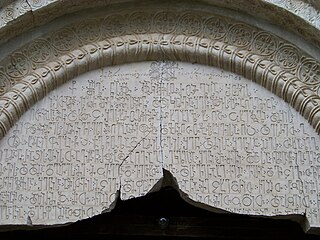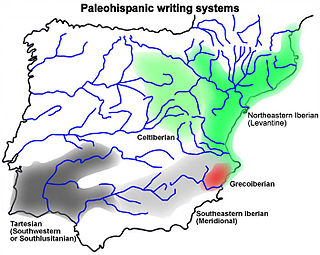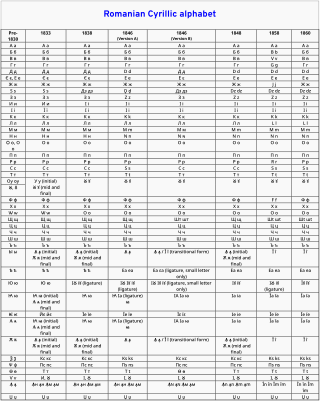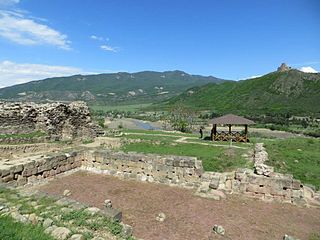The Phoenician alphabet is a consonantal alphabet used across the Mediterranean civilization of Phoenicia for most the 1st millennium BC. It was the first mature alphabet, and attested in Canaanite and Aramaic inscriptions found across the Mediterranean region. In the history of writing systems, the Phoenician script also marked the first to have a fixed writing direction—while previous systems were multi-directional, Phoenician was written horizontally, from right to left. It developed directly from the Proto-Sinaitic script used during Late Bronze Age, which was derived in turn from Egyptian hieroglyphs.

The Georgian scripts are the three writing systems used to write the Georgian language: Asomtavruli, Nuskhuri and Mkhedruli. Although the systems differ in appearance, their letters share the same names and alphabetical order and are written horizontally from left to right. Of the three scripts, Mkhedruli, once the civilian royal script of the Kingdom of Georgia and mostly used for the royal charters, is now the standard script for modern Georgian and its related Kartvelian languages, whereas Asomtavruli and Nuskhuri are used only by the Georgian Orthodox Church, in ceremonial religious texts and iconography.
Iberian refers to Iberia. Most commonly Iberian refers to:

Kurdish is written using either of two alphabets: the Latin-based Bedirxan or Hawar alphabet, introduced by Celadet Alî Bedirxan in 1932 and popularized through the Hawar magazine, and the Kurdo-Arabic alphabet. The Kurdistan Region has agreed upon a standard for Central Kurdish, implemented in Unicode for computation purposes. The Hawar alphabet is primarily used in Syria, Turkey, and Armenia, while the Kurdo-Arabic alphabet is commonly used in Iraq and Iran. The Hawar alphabet is also used to some extent in Iraqi Kurdistan. Two additional alphabets, based on the Armenian and Cyrillic scripts, were once used by Kurds in the Soviet Union, most notably in the Armenian Soviet Socialist Republic and Kurdistansky Uyezd.

The Celtiberian script is a Paleohispanic script that was the main writing system of the Celtiberian language, an extinct Continental Celtic language, which was also occasionally written using the Latin alphabet. This script is a direct adaptation of the northeastern Iberian script, the most frequently used of the Iberian scripts.

Psalm 119 is the 119th psalm of the Book of Psalms, beginning in the English of the King James Version: "Blessed are the undefiled in the way, who walk in the law of the Lord". The Book of Psalms is in the third section of the Hebrew Bible, the Khetuvim, and a book of the Christian Old Testament. The psalm, which is anonymous, is referred to in Hebrew by its opening words, "Ashrei temimei derech". In Latin, it is known as "Beati inmaculati in via qui ambulant in lege Domini".

The Romanian Cyrillic alphabet is the Cyrillic alphabet that was used to write the Romanian language & Old Church Slavonic before the 1860s, when it was officially replaced by a Latin-based Romanian alphabet. Cyrillic remained in occasional use until the 1920s, mostly in Russian-ruled Bessarabia.

Koriun was the earliest Armenian-language author. Writing in the fifth century, his Life of Mashtots contains many details about the evangelization of Armenia and the invention of the Armenian alphabet by Mesrop Mashtots. Some Armenian and European scholars, such as G. Alishan, O. Torosyan, G. Fintigliyan, A. Sarukhan, G. Ter-Mkrtchyan (Miaban), S. Weber and others, have speculated that Koriun could have been Iberian-Armenian or Iberian (Georgian).

Carrier or Déné syllabics is a script created by Adrien-Gabriel Morice for the Carrier language. It was inspired by Cree syllabics and is one of the writing systems in the Canadian Aboriginal syllabics Unicode range.

The Lithuanian press ban was a ban on all Lithuanian language publications printed in the Latin alphabet in force from 1865 to 1904 within the Russian Empire, which controlled Lithuania proper at the time. Lithuanian-language publications that used Cyrillic were allowed and even encouraged.

An alphabet book is a type of children's book giving basic instruction in an alphabet. Intended for young children, alphabet books commonly use pictures, simple language and alliteration to aid language learning. Alphabet books are published in several languages, and some distinguish the capitals and lower case letters in a given alphabet.

Armazi is a locale in Georgia, 4 km southwest of Mtskheta and 22 km northwest of Tbilisi. A part of historical Greater Mtskheta, it is a place where the ancient city of the same name and the original capital of the early Georgian kingdom of Kartli or Iberia was located. It particularly flourished in the early centuries AD and was destroyed by the Arab invasion in the 730s.

The Runa ABC of Johannes Bureus was the first Swedish alphabet book and its purpose was to teach the runic alphabet in 17th century Sweden.

The southeastern Iberian script, also known as Meridional Iberian, was one of the means of written expression of the Iberian language, which was written mainly in the northeastern Iberian script and residually by the Greco-Iberian alphabet. About the relation between northeastern Iberian and southeastern Iberian scripts, it is necessary to point out that they are two different scripts with different values for the same signs; however it is clear that they had a common origin and the most accepted hypothesis is that northeastern Iberian script derives from southeastern Iberian script. In fact, the southeastern Iberian script is very similar, both considering the shape of the signs or their values, to the Southwestern script used to represent an unknown language usually named Tartessian. The main difference is that southeastern Iberian script does not show the vocalic redundancy of the syllabic signs. Unlike the northeastern Iberian script the decipherment of the southeastern Iberian script is not yet complete, because there are a significant number of signs on which scholars have not yet reached a consensus. Although it is believed that the southeastern Iberian script does not show any system to differentiate between voiced and unvoiced occlusives, unlike the northeastern Iberian script, a recent paper defends the existence of a dual system also in the southeastern Iberian script.

The Greco-Iberian alphabet is a direct adaptation of an Ionic variant of a Greek alphabet to the specifics of the Iberian language, thus this script is an alphabet and lacks the distinctive characteristic of the paleohispanic scripts that present signs with syllabic value, for the occlusives and signs with monophonemic value for the rest of consonants and vowels.

A semi-syllabary is a writing system that behaves partly as an alphabet and partly as a syllabary. The main group of semi-syllabic writing are the Paleohispanic scripts of ancient Spain, a group of semi-syllabaries that transform redundant plosive consonants of the Phoenician alphabet into syllabograms.
A primer is a first textbook for teaching of reading, such as an alphabet book or basal reader. The word also is used more broadly to refer to any book that presents the most basic elements of any subject. Secular primer textbooks developed out of medieval religious primer prayer books and educationally-oriented revisions of these devotionals proliferated during the English Reformation.

The Armenian alphabet, or more broadly the Armenian script, is an alphabetic writing system developed for Armenian and occasionally used to write other languages. It was developed around 405 AD by Mesrop Mashtots, an Armenian linguist and ecclesiastical leader. The script originally had 36 letters. Eventually, two more were adopted in the 13th century. In reformed Armenian orthography (1920s), the ligature ևev is also treated as a letter, bringing the total number of letters to 39.

The Kartvelian languages are a language family indigenous to the South Caucasus and spoken primarily in Georgia. There are approximately 5.2 million Kartvelian speakers worldwide, with large groups in Russia, Iran, the United States, the European Union, Israel, and northeastern Turkey. The Kartvelian family has no known relation to any other language family, making it one of the world's primary language families.














